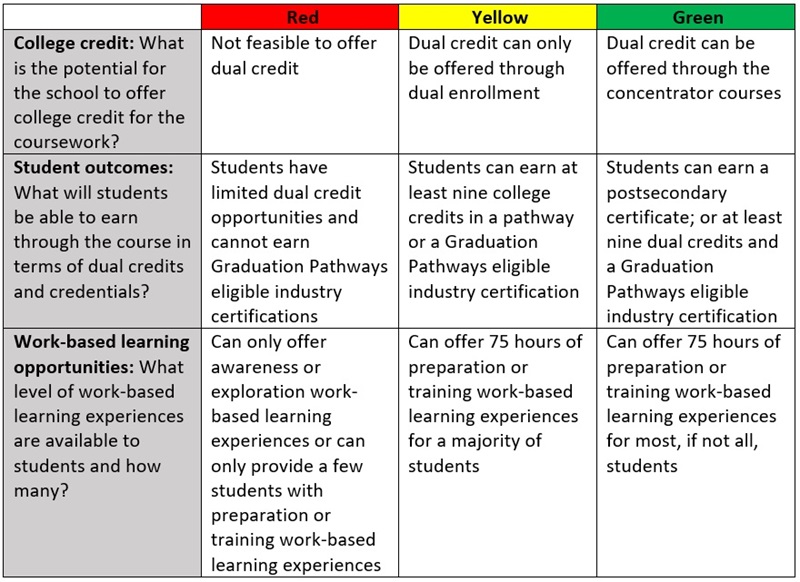For nearly a decade, leaders in Indiana have shaped state policy based on the Next Level Agenda, a series of legislative and administrative priorities that cover a wide variety of issues ranging from the economy and infrastructure improvements to the drug epidemic.
Education and workforce—and better alignment between the two—have been a pillar of the agenda from the start. Over the years, the annually updated agenda has prioritized adjusting career and technical education (CTE) funding to weight courses that allow high schoolers to earn postsecondary credentials, launching the Indiana Graduates Prepared to Succeed data dashboard, and creating career pathways for high school juniors and seniors that prepare them for a variety of postsecondary options.
Moving the education agenda forward during the 2022–23 school year, Indiana launched new secondary CTE courses. The initiative, called the Next Level Programs of Study (NLPS), aims to provide a more comprehensive and structured approach to CTE. Specifically, NLPS aims to improve CTE programming in three key areas:
- Consistency: Ensuring that all CTE students have the opportunity to master the same skills regardless of where or how they complete a program.
- Intentionality: Providing students with the opportunity to earn more postsecondary credentials—and ensuring dual credits earned in high school count toward postsecondary degrees—by directly aligning secondary courses to postsecondary competencies.
- Quality: New standards increase the rigor of courses, and improved and ongoing professional development supports instructors.
Students have the opportunity to take NLPS courses at their local high school or regional career center. Each NLPS pathway follows the same structure and consists of a four-course sequence. First, there is a two-credit principles course where students learn foundational content that’s applicable to multiple closely-related programs of study. Next, there are two concentrator courses—worth two credits each—where students acquire the knowledge and skills needed for a particular occupation, and can obtain industry-recognized credentials whose requirements are integrated into their courses. Once a student has completed these three initial courses, they earn CTE concentrator status. Finally, students complete their program of study by enrolling in a capstone course that’s worth between two to six credits and includes time for embedded work-based learning opportunities like internships.
All this is great news for Indiana students and schools. But what about the Buckeye State? Why should what’s happening in Indiana matter to Ohioans?
For starters, it’s a model for how to align programs and courses across a state without robbing schools of local control. The NLPS planning guide notes that, although the overhaul creates greater consistency and expectations across all CTE pathways, it still provides schools with “a great deal of flexibility” to offer programs of study in different ways. Time will tell if Indiana has struck the right balance, but so far, they seem to be off to a good start that Ohio could take some cues from.
But that’s not all. Indiana’s planning guide also contains a potential solution for two of the biggest concerns about Ohio’s CTE sector: rigor and quality. Right now, Ohio leaders don’t have an easily accessible, simple, and effective way to objectively evaluate whether the career pathways available to students lead to meaningful postsecondary opportunities, well-paying jobs, and better outcomes overall. Similarly, it’s unclear whether the industry-recognized credentials students are earning are meaningful to employers and thus worth the time and effort it takes to earn them. The state’s CTPD report cards and Quality Program Reviews shed some light, but not nearly enough, and not in an easily understandable way.
The NLPS planning guide offers a potential roadmap for how Ohio could revamp and streamline its assessment of rigor and quality in CTE programs. The guide notes that going forward, all of Indiana’s CTE programs will be monitored based on their performance on Measures of Program Quality. Some of these components—college credit, student outcomes, and work-based learning opportunities—are related to measures of program quality within Perkins V, the federal law governing CTE programs and funding. That makes them easily transferable to Ohio, which also operates under Perkins. But the additional components are also critical and include employer engagement, equity and access, career development, and sustainability/continuous improvement.
The planning guide does more than identify each component, though. It also offers a rubric designed to evaluate whether a program has failed, met, or exceeded expectations for the specific components. Consider Indiana’s rubric for the Perkins-aligned measures of program quality below. Using an intuitive traffic light color system, the state identifies three different levels of quality for each component.

To be clear, Ohio also provides rubrics as part of its Quality Program Standards for CTE programs. But Ohio’s rubrics are much more complex than Indiana’s. For example, each of Ohio’s ten standards has its own rubric, and each rubric has several indicators and four levels of performance. Amidst all this complexity, crucial data about student outcomes can get lost. The Quality Program Reviews, at least, are limited to just three performance measures: technical skill attainment, work-based learning, and post-program placement. But there are issues there, too. For example, the post-program placement measure only includes students for whom placement is known; if a district is unable to locate a former student, then that student just isn’t included in the calculation. (CTPD report cards are even more complex.)
In short, Ohio’s system could use some streamlining and some additional emphasis on student outcomes. Obviously, lawmakers can’t just copy and paste Indiana’s system into the Buckeye State and expect it to work flawlessly. Ohio has done a lot of great CTE work over the last few decades, and some of that work is worth keeping. It’s also important to gather stakeholder feedback and to consider Ohio’s unique context when drafting policy—especially policy that will monitor the performance of providers, and thus could be controversial.
But state leaders should do something. More students are earning industry-recognized credentials than ever before. Graduation requirements allow students to earn a diploma based on technical skills. The recent state budget allocated hundreds of millions to CTE programs, and state leaders are regularly introducing new initiatives aimed at improving alignment between education and workforce. Despite all this investment—and our complicated quality review systems—it remains unclear which and how many of Ohio’s CTE programs are rigorous, and whether the industry-recognized credentials students are earning are valuable and meaningful.
Students, families, and communities deserve better and more transparent information, as well as a CTE framework that can adapt and improve based on the needs of industry and students. Following Indiana’s lead could be a good first step toward building such a framework here.


